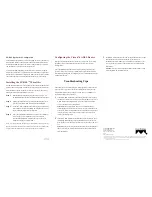
Quick Start
F O R
T
H E
C
I S C O
6 7 6 A D S L R
O U T E R
Introduction
The Cisco 676 is an Asymmetric Digital Subscriber Line (ADSL)
modem used for home connectivity to an ADSL service provider
network over an ADSL/Asynchronous Transfer Mode (ATM) physical
layer. The Cisco 676 router receives adaptive rates of up to 9.2 Mbps
downstream and transmits .8 Mbps upstream. The Cisco 676 router
operates using the Cisco Broadband Operating System (CBOS).
Reference Material
Before you install the Cisco 676, please have the following media
available for reference:
•
Cisco 676 ADSL Router Installation and Configuration Manual -
Document Number 78-6036-01
•
Cisco Broadband Operating System User’s Guide - Document
Number 78-5803-01
System Requirements
The following provides a quick overview of the hardware and software
requirements necessary to install and configure the Cisco 676 ADSL
Router.
•
A personal computer or a computer connected to a server-based
network.
•
A system-resident terminal emulation application.
•
A DB9 serial port.
Note: If only a DB25 serial port is available on the computer, you must
also use a DB9-to-DB25 adapter to connect the serial cable to the
computer.
•
An Ethernet port or adapter, or a connection to the immediate local
area network (LAN).
Getting Help
If you have purchased your equipment through an outside or third-party
vendor, please contact the vendor who supplied your equipment, or contact
your Internet Service Provider for technical support information.
If you have purchased your equipment directly from Cisco, contact the
Cisco Technical Assistance Center, 24 hours a day, 7 days a week, at 800
553-2447 and at [email protected].
Installing the Cisco 676 ADSL Router
The following sections will provide the information necessary to install the
Cisco 676 ADSL Router. Please refer to Chapter 2 of the Cisco 676 ADSL
Router Installation and Configuration Manual for detailed installation
instructions and procedure illustrations.
Connecting the Cables
Figure 2-7 in the “Cisco 676 ADSL Router Installation and Operation
Manual” shows where to connect all cables to the rear panel connectors of
the Cisco 676 ADSL Router.
Step 1
Plug the power connector into the back of the unit.
Step 2
Connect the Ethernet cable to the Cisco 676 ENET connector.
Step 3
If the computer at the customer premise has only a single
Ethernet-equipped computer, attach the Cisco 676 to the
computer’s Ethernet adapter with the crossover cable provided.
Otherwise, connect the Cisco 676’s Ethernet port to an Ethernet
hub using a straight-through cable.
Step 4
Connect the provided telephone cable to the Cisco 676 WALL
connector and then connect the other end of the cable to the
telephone wall-mounted connector.
The POTS Splitter Configuration
A POTS splitter separates data signals from voice signals on your phone
line. The POTS splitter works by running a separate data line from the voice
line, so that the ADSL modem has a dedicated cable for data transmission.
Figure 2-4 in the Cisco 676 ADSL Router Installation and Operation
Manual shows a POTS splitter configuration. If you are using an external
POTS splitter, connect the provided telephone cable to the wall connector
that is labelled as going to the external POTS splitter.
Note: Contact your service provider if you have questions regarding your
configuration.




















